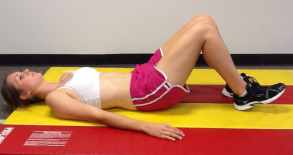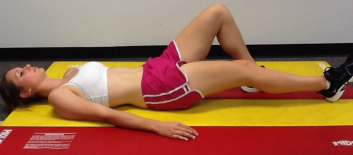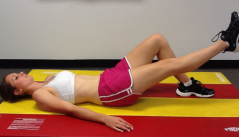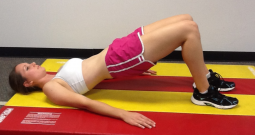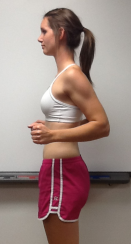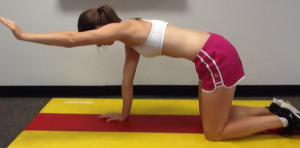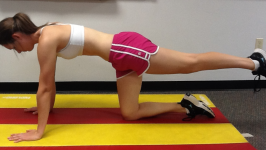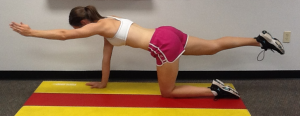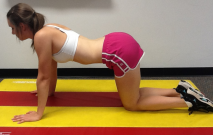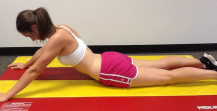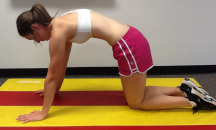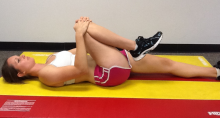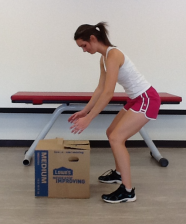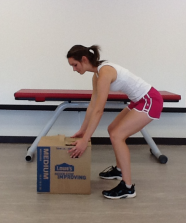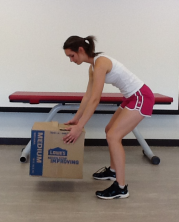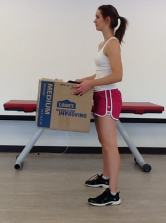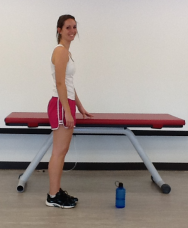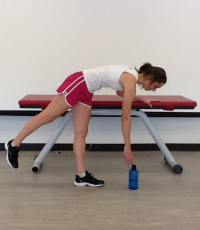Back Exercises
Original Editor - User Name
Top Contributors - Lucinda hampton, Oluwasegun Ajenipa, Kim Jackson and Oyemi Sillo
Introduction[edit | edit source]
Today, exercise is recognized for its importance to healthy lifestyles, longevity, quality of life, mental health, and the management of many chronic diseases, including low back pain. Exercise is the best way to increase functional capacity.
For the acute back pain patient, early activation towards normality that includes exercise should begin in the primary care setting. Unfortunately, a large percentage of primary care physicians do not recommend exercise to their back pain patients.
Good evidence supports the use of exercise-directed therapy for patients with chronic back pain. When compared with other therapeutic approaches, exercise demonstrates positive results by itself and in combination with cognitive interventions[1].
Abdominal bracing[edit | edit source]
- Abdominal bracing with heel slides
- Abdominal bracing with leg lifts
- Abdominal bracing with bridges
- Abdominal bracing with standing row exercise
- Abdominal bracing with walking/standing
Erector Spinae/Multifidus[edit | edit source]
- Quadruped arm lifts and bracing
- Quadruped leg lifts and bracing
- Quadruped alternate arms and legs with bracing
Extension Based Exercises[edit | edit source]
Cow Stretch
Prone Press Ups
Flexion Based Exercises[edit | edit source]
Williams' flexion exercises - 1) the pelvic tilt 2) the single knee to chest stretch 3) double knee to chest 4) partial sit-up 5) hamstring stretch 6) hip flexor stretch and 7) squatting.
Cat Stretch
Prayer Stretch
Single Knee to Chest
Lumbar Stabilization Exercise[edit | edit source]
Stabilization exercise programs are used to improve the strength, endurance and/or motor control of the abdominal and lumbar trunk musculature. The stabilizing exercises focus on the re-education of a precise co-contraction pattern of local muscles of the spine.
It had been shown that stabilizing exercises along with routine exercises help with the reduction of pain intensity while increasing functional ability and muscle endurance and are recommended in the treatment of patients with lumbar segmental instability.
The following videos are examples demonstrating progressions of spinal stabilization exercises that can be used for patients requiring this technique. They can and should be modified according to specific patient needs, preferences, or functional demands. The physical therapist should remember to consistently stress the importance of maintaining a neutral spine when performing these exercises.
| [2] |
[3] |
Hamstring stretch
Pelvic Tilts in supine lying or standing close to the wall
Proper Lifting Techniques[edit | edit source]
Squat lift
- Plan The Lift: Know how heavy the object is. Clear a path and know where the object is to be placed.
- Lift Close to the body: This will make the body stronger and more stable. Ensure there is a firm hold on the object and balance it close to the body.
- Feet shoulder width apart: This allows for a solid base of support.
- Bend the knees while keeping the back straight: Avoid any twisting motions.
- Tighten the stomach muscles: This will hold the back in good alignment and prevent excessive force on the spine. Avoid breath holding.
- Lift with the legs: The leg muscles are stronger than the back so use them.
- Avoid straining, get help: Get help if the object is too heavy or it is in an awkward position.
Squat - Remember to:
- Keep back straight
- Knees behind toes
- Keep knees parallel
Golfer’s Lift
- The Golfer’s lift is another lifting technique that is useful for picking something off the floor
- This works best when using something like a chair or table for support when bending
- Kick out the unsupported leg - This helps to keep the back straight
Diagonal Standing
- Stand with one foot slightly in front of the other and distribute the weight evenly between both legs
- This is a preferred position over straight standing
- Avoid putting all of the weight onto one leg while standing.
Aerobic Activity [4][edit | edit source]
Types: Walking, jogging, running, cycling, swimming, climbers, steppers, elliptical machines, ski machines, aerobic dance
Warm up/cool down – low to moderate activity
- 5-10 minutes of warm up (adjust to demands placed on the body)
- 5-10 minutes of cool down (recovery of heart rate and BP)
- 10 minutes of stretching AFTER the warm up OR cool down
ACSM Guidelines:=
- Frequency: 5 days/week
- Duration: 150 minutes per week (minimum)
- Intensity: 40-60% HRmax (HRmax = 220-age)
Benefits of exercise are improved joint health due to low impact exercises, increase bone density due to weight bearing exercises, improving energy, reducing health risks, improving circulation, and reducing stress and improving your mood. Aerobic activity is equally effective at reconditioning muscles as exercise and can also help in decreasing pain, improving your mood, and improving your functional capabilities.[5] Lack of exercise increases your risk of obesity and other co-morbidities increases; this can lead to increased pressure on the spine and decreased flexibility.
- bulleted list
- x
or
- numbered list
- x
References[edit | edit source]
- ↑ Dreisinger TE. Exercise in the management of chronic back pain. Ochsner Journal. 2014 Mar 20;14(1):101-7. Available: https://www.ncbi.nlm.nih.gov/pmc/articles/PMC3963038/(accessed 10.2.2022)
- ↑ online video, http://www.youtube.com/watch?v=zJ63XJQbp7k, last accessed 6/2/09
- ↑ online video, http://www.youtube.com/watch?v=bsJ7smHAyJk, last accessed 6/2/09
- ↑ Thompson WR, Gordon NF, Pescatello LS, eds. ACSM's Guidelines for Exercise Testing and Prescription. 8th ed. Baltimore: American College of Sports Medicine; 2010.
- ↑ Hettinga D, Jackson A, Moffett J, May S, Mercer C, Woby S. A systematic review and synthesis of higher quality evidence of the effectiveness of exercise interventions for non-specific low back pain of at least 6 weeks' duration. Physical Therapy Reviews [serial online]. September 2007;12(3):221-232. Available from: CINAHL with Full Text, Ipswich, MA. Accessed October 6, 2013.
